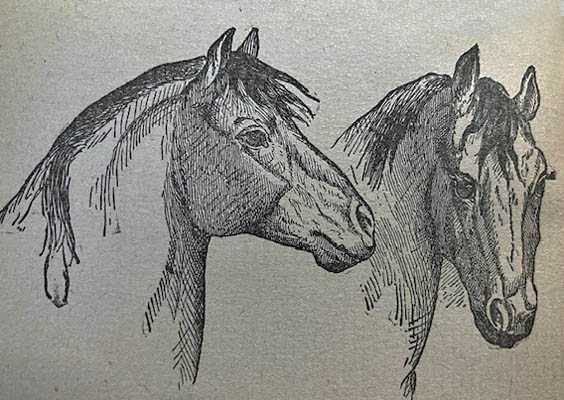So, You Think You Love Horses?
Some Reflections on the Nature of Horses and Man
Glossary of Equestrian Terms
Words Beginning with F
-
Falabella Miniature Horse
[Equine Breed] Falabellas are a breed of miniature horse deliberately bred in Argentina, originally by Patrick Newtall and later by Juan Falabella. They have the portions of the usual horse, but a miniature size, typically standing between 6.1 and 8 hands. Technically that would be make them a pony but you never see that word associated with them. They are too small to be ridden by an adult, but they were bred as a pet and for their novelty value. Some older people, who had enjoyed keeping horses, find them a great retirement animal that can be kept in a smaller farm that a usual herd of larger animals.
-
Falling Into the Ring (Falling In the Circle)
[Training] A horse is said to fall into the ring when being schooled it tends to drift toward the center of the ring rather than maintain a fixed course along the border of the ring. This may be the result of a natural tendency on the part of the horse and also the rider not employing sufficient aides to hold the horse on course. Beginning riders often lack the strength in their legs to prevent a horse from falling into the ring.
-
False Martingale
[Equine Equipage] False Martingales are used in driving horses and are designed to keep the breastplate in place. They run from the girth to a fitting on the breastplate. The difference is that a false martingale does not affect the horse's head position, only the breastplate placement, unlike a standard martingale which is used to manage the horse's horizonal head movement.
-
Farrier
Farrier at Work
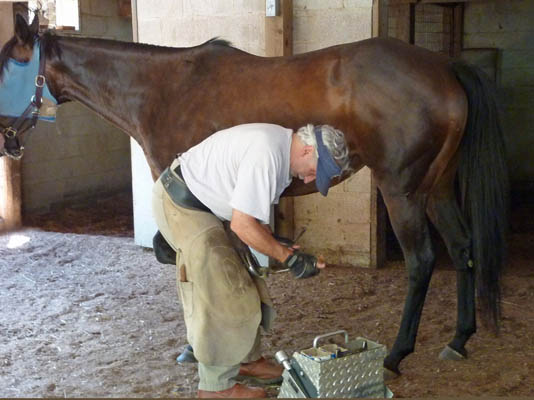
|
[Equine Professional] A blacksmith, who specializes in shoeing horses and caring for horses' feet. Most owners defer to trained professionals but some do their own shoeing. Poor shoeing can result in a lame horse.
-
Far Turn
[Horse Racing] The far turn is one of the four sections of an oval race track and is the second turning section, which that follows the straight backstretch section and leads to the homestretch section and finish line.
-
Feathers
[Anatomical Term and Breed Characteristic] Long tufts of hair running up the leg from the fetlock and found in many breeds of draft horses..
-
Fecal Egg Count
[Veterinary Medicine] A fecal egg count is performed on a stool sample to establish the degree of parasite infestation.
-
Fédération Équestre Internationale (FEI)
[Equestrian Sport Organization] The Fédération Équestre Internationale (FEI) is the French official name for what is named in English as the International Federation for Equestrian Sports. They set standards for International competition and rules for the care and safety and the horses involved in the competition. A number of well-known individuals with an interest in equestrianism have served as its president, including Prince Philip, Princess Anne, and Princess Haya bint Al Hussein of Jordon but only once has it had an American has its president.
-
Feelers
[Surface Anatomical Term] Feelers are the long hairs surrounding a horse's eyes. Because horses are unable to see objects directly in front of their eyes, these hairs function as a sensory organ that allow horses to feel rather than see in that space. Stimulation of these can trigger a blink response.
-
Flecked
[Equine Coat Characterization] A flecked horse has irregularly distributed small collections of white hairs in tis coat.
-
Flemish Horse
[Equine Coat Characterization] Flemish horse is a Belgian breed of heavy draught horse. It was known from medieval times and imported into England as a war horse. However, Flemish horses, like so many other drafts, suffered as a result of the world wars and the breed has only recently been reestablished.
-
Fell Pony
[Equine Breed] Fell Ponies originated in the Counties of Cumberland and Westmorland in northwest England. Unlike so many of the other British pony breeds a wild population does not exist. They process hardiness, agility, strength and sure-footedness, important in the local mountainous region.
-
Fence Line
[Pasture Management] The Fence line is the that path pasture fencing follows. The ground directly under it has an ecology distinct from the rest of the pasture and it deserves special consideration. While the rest of the pasture can be easily mowed to suppress weeds, the region along the fence is more difficult to care for. Without care the fence line soon resembles a weed, tree and shrub line. Neglect creates situations that the fence itself can deteriorate more quickly than a well-maintained one, aesthetics aside. Birds will sit on fence lines and their excrement adds seeds of local plants to the area. Fence lines soon becomes a haven for a wide variety of unwanted plants and perhaps ones toxic to horses. I try to regularly use a weed trimmer along the fence line and on occasion uproot persistent weeds and scrubs. A word to the wise, watch out for yellow jackets.
-
Fender
Western Saddle with Fender
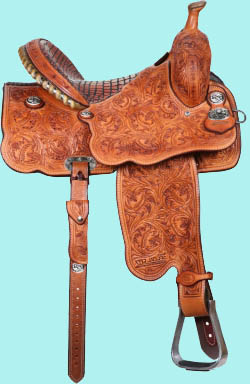
|
[Equine Equipage] A fender is a wide leather panel situated on the sides of a western saddle between the seat and the stirrups that keeps the rider's legs from rubbing the horse's sides.
-
Fetlock
[Anatomical Term] The metacarpophalangeal joint of a horse's leg between the cannon bone and the pastern, which corresponds to the human upper knuckle in the hand. It bears a tuft of hair.
-
Fever Rings (Founder Rings)
[Veterinary Medicine] Fever rings are horizontal bands visible on a horse's hoof that are evidence of a growth disturbance from some kind of stress. They may result from high fever, founder, inflammation, ingestion of a toxic plant or dietary change.
-
Field
[Fox Chasing] The field consists of the members and guests of the hunt that are following the hounds during a particular day, The master and staff are not considered part of the field. As a general rule the master and staff wear "pinks," red or scarlet coats that stand out on the hunt field. The field generally wear black or dark navy blue coats.
-
Field Master
[Fox Chasing] The field master is a staff member of a hunt responsible for conducting the field of hunt members and their guests on the hunt. A field master's presence allows the master to be up ahead and more fully concentrate on the hounds. Protocol demands that members not ride past the field master and certainty never pass the master.
-
Fillis Stirrup
Fillis Stirrup
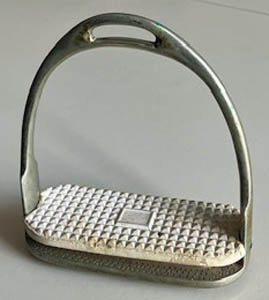
|
[Equestrian Equipage] A Fillis stirrup is a commonly-used type of stirrup for English riding. Its sides curve to the slot that the leathers fit into and the edges of the base are rounded.
-
Filly
[Equine Terminology] A filly is a female horse that is less than four years old and has not herself had a foal. If she has had a foal then she is termed a mare, regardless of age.
-
Finial Halt
[Dressage] At the close of a dressage test the rider ends facing the judges and brings the horse to a straight, four-square stop, holding the position for a few moments and then salutes the judges.
-
Fistulous Withers
[Veterinary Medicine] An inflamed and draining chancel developing from inflammation and infection in the supraspinous bursa in the withers area, usually the result of poor fitting tack.
-
Fitch Metal Curry Comb
Fitch Metal Curry Comb
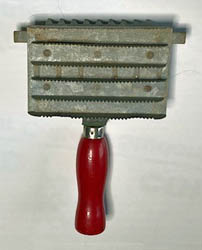
| 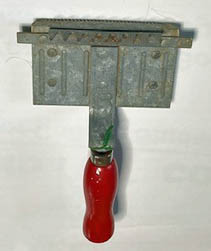
|
[Grooming Implement] The Fitch curry comb is a special purpose comb used to remove caked-on mud on horses with a heavy winter coat or to clean brushes. It is too harsh to use on horse's summer coats. The design is a very old one.
-
Five-Gaited Horse
[Equine Gait Classification] Five-gaited horses are from breeds that possess five natural or manmade gaits. American Saddlebreds are five-gaited, having a walk, trot, canter, slow gait (a four-beat stepping pace) and rack (a fast four-beat gait with equal intervals between each footfall). Icelandic horses are also five-gaited, having a walk, trot, canter, tolt (a smooth, four-beat lateral gait) and flying pace.
-
Fixed-Ring Full Cheek Snaffle Bit.
Fixed-Ring Full Cheek Snaffle Bit
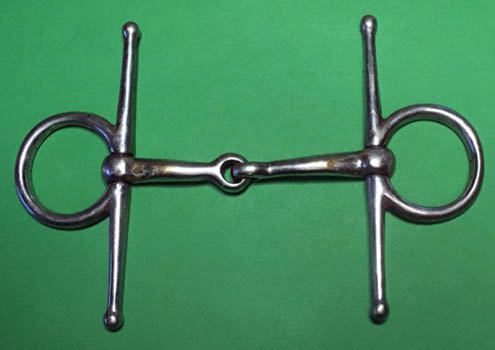
|
[Equine Equipage] A fixed-ring variation of a full cheek snaffle bit is very similar to the loose-ring variation of a full cheek snaffle bit (Fulmer bit), except that the ring is fused into the arm of the bit and not movable by itself.
-
Fixture
A Hunt Assembling at a Fixture

|
[Fox Chasing and Polo] A fixture is a frequently-heard term for the venue of the particular hunt or match. They are used for hunting with the permission of the land owner and are a prized location within the territory of the hunt. Many fixtures over time are lost to development. In polo it is the particular field that will be used.
-
Fixture Card
[Fox Chasing] A fixture card is a notice delivered to hunt members that announces hunt dates and places and constitutes an invitation to hunt.
-
Fjord Pony
Fjord Pony (courtesy of Wikipedia and "Plasma"
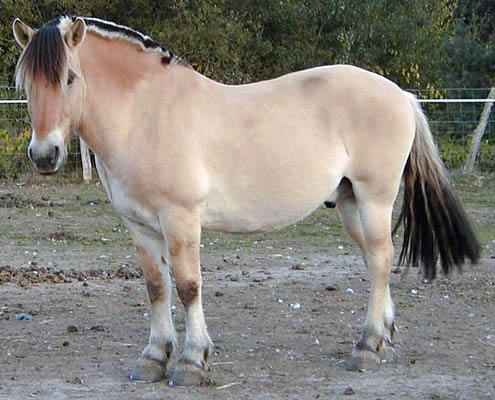
|
[Equine Breed] Fjord ponies are native to Norway, They have a dun coat color and a mane trained to stand upright,
-
Flag
[Vaulting] The flag is a vaulting compulsory competition move in which the rider poses on resting on one knee with the other leg stretched out to the back and the opposite arm extended forward on the moving horse's body.
-
Flank
[Equine Anatomy] The flank is the area of a horse's body between the ribs and the hip.
-
Flank
[Vaulting] The flank is a vaulting compulsory competition move in which the rider dismounts by swinging up into the air and releasing to land on the feet.
-
Flask (Hunting Flask
I wonder what these gentlemen's blood alcohol level was?
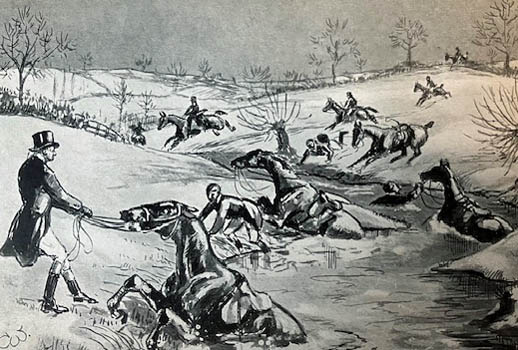
|
[Fox Chasing] Fox chasing being a winter sport, many participates appreciate an alcoholic beverage in the course of the chase. Flasks might be carried in a leather holster or in a sandwich case. I have always felt that one of the reasons so many old hunt prints portray members being separated from their mounts is that they were less than sober. I do not own a flask nor have partaken of one but others can do as they wish.
-
Flat Racing
[Equine Racing] The most common form of racing in this country is flat racing. The races are conducted at race tracts with professional jockeys and allow parimutuel betting. Jockeys ride on a flat tract astride without any obstacles to jump. The surfaces ridden on may be turf, dirt, and artificial or synthetic. Harness racing and steeple chasing are not flat races.
-
Flax
[Equine Supplement] Flax seeds are fed to horses in order to improve the coat, skin and hoof and as a source of omega-3-fatty acid.
-
Fleece
[Equine Equipage] Fleece can be made from synthetic materials, sheepskin, or wool. Fleece pads well and is soft against a horse's skin and whisks sweat away from the skin . However, it can be more difficult to clean and may cause the rider to inadequately tighten his girth. It is used in saddle pads, girths, padding on other points of contact. In many cases the fleece pad slips over leather tack.
-
Flehmen Response (Flehmen Face)
Flehmen Response
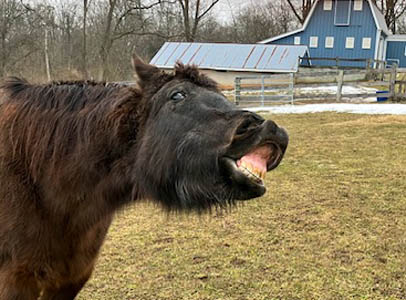
|
[Equine Behavior] The flehmen response is an voluntary behavior seen in horses as a response to an unfamiliar odor or when investigating an odor. It facilitates the transfer of scent molecules, including pheromones. into the vomeronasal organs located in the nasal septum. In humans the vomeronasal organs are nonfunctioning. When a horse reacts it curls its upper lip back, wrinkles its nose and lifts its head. Flehmens are very common in stallions, common in mares and uncommon in geldings.
-
Flemish Horse (Flemish Great Horse)
[Equine Breed] The Flemish Horse is native to Belgium that was originally bred to carry the weight of an armored knight. When the nature of warfare changed they were used as draft horses and interbred with another draft bred, the Brabant, to create a bred known as Belgian Draughts. The Second World War devastated the draft horse population in Europe and the Belgian Draught all but disappeared. About 1993 an effort was made to reestablish the bred. However, numbers are still small and the breed is still at risk.
-
Flights
[Fox Chasing] In fox chasing (hunting) the field of participants are subdivided into flights or fields, based on their abilities and experience. The first flight (first field) consists of the most experienced riders and horses and will stay closest to the huntsman and hounds, often covering challenging terrain and obstacles to jump. The second flight (second field) of riders plays it easy and can go around obstacles and not jump, hanging behind the first flight. Lastly, there can be a third field that does not jump or even gallop. They are often older members, younger children, inexperienced riders and riders on green horses. Each flight is assigned its own field master.
-
Floating of Horse's Teeth
Floating with a Hand Tool

|
[Equine Dentistry] Floating is a procedure that removes irregular sharp edges or hooks from the occlusal surfaces of horses' teeth. Over time these form with grazing and can interfere with the animal's nutrition. A device with rasp-like teeth that can be hand-held or electric powered is used, often in conjunction with a speculum-like apparatus, keeping the mouth open. Many horses required mild sedation to perform the procedure, which is not that lengthy.
-
Fly Control Measures
[Stable Management] See my discussion under fly predators. These measures include good manure management practices, manipulation of environmental factors (air streams, lighting, etc.), traps, coverings (fly masks and sheets), fly predators and fly sprays, including ones sprayed on stall surfaces, and diflubenzuron containing feed additives that effect fly larva in manure.
-
Fly Cap
Fly Cap
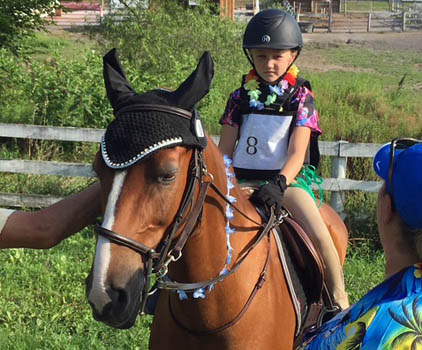
|
[Equine Equipage] A mesh covering for a horse's ears, designed to keep flies away from them. They have decorative features.
-
Fly Fence
[Fox Chasing] Any jump on the hunt field that can be cleared at a gallop.
-
Fly Mask
[Equine Equipage] A mesh covering for a horse's head, sometimes including the ears, that is designed to keep flies away from the face. I tend to remove them at might and replace them in the morning. They are held on with Velcro and will come off should the horse somehow taggle them in something. I find myself walking the fields to find one that a horse has pulled off.
-
Fly Predators
[Fly Control Measures] Fly predators are commercially available mixtures of several species of small fly predating wasps. The eggs are distributed in the locale and hatch these wasps. I used them for several years running, putting them in and around the manure pit, and cannot say that I noticed a noticeable difference in the fly population. Fly predators do not target greenheads, yellow flies, deer flies or horse flies. Interestingly, these flies will break off their attack if the horse runs in a darkened stall. The breeze of a fan also helps. I found the fly traps must more effective, but it is easier to note what they are doing relative to the predators. I am sure others found them more effective.
-
Fly Sheet
[Fly Control Measures] Fly Sheets are light weight horse blankets worn in the warm weather to keep biting insects away from horses. Some offer more coverage them others.
-
Fly Whisk
Fly Whisk
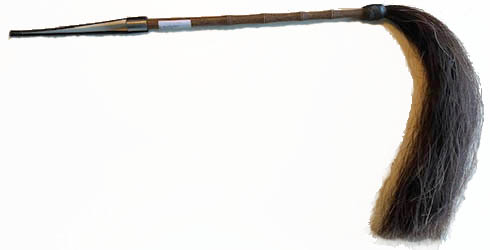
|
[Horse Comfort Measure] Fly whisks are a crop-like device used to whisk flies away from horses. They have a handle and loop to secure them like a crop to the rider's hand and a clump of horse hair resembling a horse's tail on the other end. They are surprisingly effective in practice to discourage flies that have landed and about to bit. You can generally hit a horse fly flying around your mount in the air before it lands and continue until it flies away without landing. Only then you can stop holding your breath. Deer flies are particularly very tenacious, but generally land where they can be dispatched with a good swat of the hand. I never leave home without a fly whisk in the summer. There have been times when repeated fly attacks were so numerous that we just gave up and cantered home. Horse flies will continue their attack even if your horse is at a gallop.
-
Flying Change
[Dressage] During a flying change the horse is signaled to execute a lead change while in in the air cantering between two strides. This might be continued in a series with each stride and referred to as tempi changes. It is difficult to execute and indicative of a skilled rider and well-schooled horse. The rider via a series of signals indicates the movement and keeps the horse from breaking stride to the walk or trot.
-
Flying Pace
[Equestrian Gait] The flying pace is the storied 5th gait of the Icelandic horse that only certain Icelandics can consistently preform. It is a very fast gait in which where a horse can go up to about 45 km/h for a short distance.
-
Foal
Foal
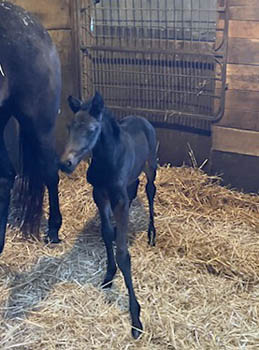
|
[Horse Status] A foal is a young horse under the age of one year. A male under the age of four is a called a colt and a female is a filly.
-
Foal Heat
[Veterinary Medicine] Foal heat is the first estrous period in mares after foaling, commonly occurring 6-12 days post-partum. It is a opportunity to rebreed brood mares and ensure a foaling date around the same time each year. However, many believe that the uterus needs more time to recover.
-
Foaling Stall
[Horse Housing] A foaling stall is a square or rectangular enclosure in a barn or stables used to house a mare during and after the birthing process. Although similar to a box stall it should be larger with recommended dimensions of at least 12' x 18', but ideally 12' x 24' or 20' x 20.' The recommended bedding material of a foaling stall is straw as other materials can be irritating. I also must be free of any elements that might cause injury to a curious foal.
-
Footing
[Functional Riding Surface] The footing describes the nature and condition of the surface that a horse is moving over. The nature of the footing might be turf or sand, etc. The condition of the footing might be too hard, too soft too slippery, etc. Rider must evaluate the footing for any risks or limitations do to its condition,
-
Footman
[Coaching] A footman was a liveried servant who rode on the back of a coach and was in a position to jump off if needed in the course of a trip, including guarding against highwaymen. They also were given various indoor jobs in the household when the coach was not in use..
-
Forehand
[Anatomy] That part of a horse that is situated in front of the position of the rider.
-
Forelock
[Anatomy] A tuft of hair growing forward from the mane between a horses ears. This covers part of the forehead and his useful when a horse stakes its head to discourage flies. It was customary to clip it off with certain breeds.
-
Forging
[Gait Problem] Forging occurs when a shod horse strikes its front shoe with the back one while at a trot or pace. It can corrected by corrective shoeing by a farrier.
-
Founder
[Veterinary Medicine] Founder or laminitis is an inflammatory condition of the laminae of the hoof in horses. There are many potential causes but ingestion of excessive amounts of grain or being placed on a rich pasture are common situations. Ponies are particularly susceptible. The types of founder include: road founder, grain founder, metabolic founder, grass founder and trauma founder. The affected animal may run a fever and avoids bearing direct weight on the involved limb. The hoof is warm to the touch and applied pressure pressure produces pain. An animal may recovery from a mild case but the prognosis is poor in more severe cases. Founder is best prevented.
-
Four-in-Hand
[Driving] A four-in-hand is a carriage or coach, drawn by a team of four horses and having the reins that it can be used by a solo driver. It also describes the act of driving such a carriage.
-
Forward Seat (Jumping, Hunt or Hunter Seat)
[Basic Riding] The forward seat is one of three principle seat positions in riding. A rider sitting in a forward seat is carrying weight forward and just behind the horse's withers as opposed to the classical seat in which the weight is carried farther back and more over the spine. English saddles variations are designed either for forward or classic seat riding. The forward seat is useful in more athletic riding; such as, jumping and used in fox chasing. The classical seat, also called the equitation position, is used in dressage.
-
Fox Chasing
Fox Chasing

|
[Fox Chasing] In our era of exploding euphemisms what was known as fox hunting is often now referred to as fox chasing and I am using that term. Fox chasing may be a more accurate name as participants are more interested in a good chase than catching a fox and some hunts will use an artificial scent trail rather than hunt a actual fox. Even so, it is still true that hounds may rarely corner and kill a fox before the staff can intervene. The original intent of fox hunts was to rid the countryside of what were considered vermin and my neighbors still lose a lot of domestic fowl to foxes, coyotes and raccoons. I figure such is the way of nature and who am I to keep chickens anyhow.
-
Frangible Pins
[Outdoor Jumping Courses] Frangible pins allow the upper sections of cross country jumps to fall if a horse knocks against it. They function to increase safety on course and prevent injuries to horses and riders. I assume at this point most of the older course jumps do not have frangible pins.
-
Frederiksborger Horse
[Equine Breed] Frederiksborgers are an rare breed of Danish draft horse. They date from the 16th century and are attractive horses, used under harness or ridden astride.
-
Free Jump
[Ground Work] In a free jump the horse is school over fences without a a rider mounted on its back. This is part of the initial training given to the horse in jumping.
-
Free Lease
[Horse Management] A free lease is an agreement between a horse owner and a lessee in which the lessee agrees to provide total care of the animal in exchange for the right to ride it.
-
Free Longe (Longe at Liberty or Free School)
[Ground Work] Free longing is working a horse in a ring without the use of an attached longe line. The trainer employs a whip, voice commands and posture to school the horse.
-
Free Rein
[Basic Riding] Most of the time a rider has contact with the reins, but on free rein the reins are relaxed and the horse allowed to lower and extend its neck. This would be done standing or at a slow walk. He rider is still holding the reins. The rider should be prepared to take up the reins if there is any trouble.
-
Freestyle
[Dressage] In upper level dressage freestyle competition the rider is allowed to create their own routines set to music of their choice, rather than follow a prescribed dressage test, which is the usual in dressage. They are then judged on their overall performance and the creativity of their routine.
-
French Link Snaffle Bit
French Link Snaffle Bit
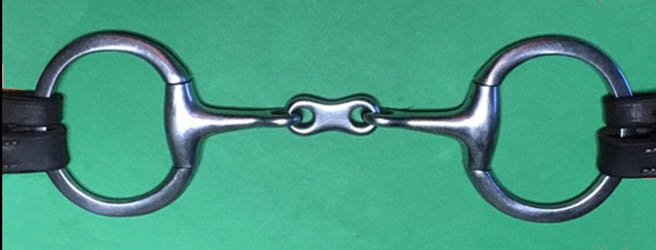
|
[Equine Equipage] A type of multi-jointed snaffle bit that has a additional central mouthpiece link consisting of a smooth metal plate that distributes the load in the region of the tongue. Unlike the similar Doctor Bristol snaffle, the French link's mouthpiece is in the plane of the bit rather than at an angle. It is considered to be a mild bit for the horse
-
Friesian Horse
Friesian Stallion
(Courtesy: Wikipedia)
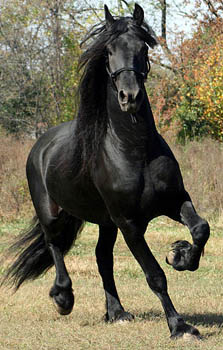
|
[Equine Breed] Friesians are native to the Friesland, a province of the Netherlands. They generally are of a solid black color but rarely are chestnut. Except for the occasion animal that has a small white forehead star they should have no white markings of any kind. They have finely formed heads and arched necks and are strongly built, energetic in their movements and often with elegant flowing manes and tails.
-
Friends of Ferdinand
[Equestrian Benevolent Organization] Friends of Ferdinand is an Indiana-based non-profit Thoroughbred aftercare alliance that advocates for retired racehorses. It is named after a 1987 Horse of the Year and Kentucky winning stallion whose life tragically ended in a Japanese slaughter house.
-
Frog
[Equine Anatomy] The frog is a triangular area of softer tissue located toward the back of the bottom of a horse's hoof, It acts as a shock absorber and also serves to force blood return from the horse's leg when the horse is moving. If the human nail is like the horse's hoof, the very tip of the finger would be the frog. When picking a horse's hoof foreign matter should be carefully removed between the the horn and the frog.
-
Full Collar Harness
[Driving] A full collar harness is a harness type that incorporates a oval-shaped horse collar to the design in order to distribute the load around a horse's neck and shoulders, which are the more desirable pulling points on the horse's anatomy. The collar is attached to the traces, which are the two straps or chains which run to the vehicle and complete the harness body.
-
Full Cry
[Fox Chasing] A fox hound pack running on a strong scent and often loudly crying out is in full cry.
-
Full Pass
[Dressage] In a full pass the horse moves almost entirely sideways with minimal forward movement, crossing its legs as it moves and as distinct from a half pass in which the horse moves both forward and sideways on a diagonal line.
-
Fulmer Bit
A Fulmer Bit
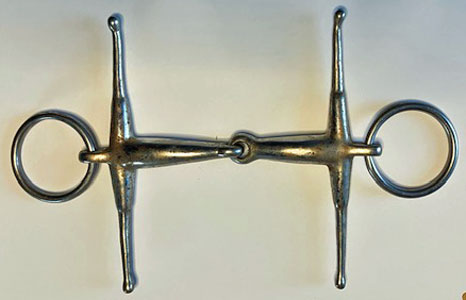
|
[Equine Equipage] The Fulmer bit is a loose-ring variation of a full cheek snaffle bit. Loose rings make the bit much more moveable. There is a bend to one set of the cheek extensions to better conform to the taper of a horses face.
-
Furlong
[Horse Racing] A furlong is a distance equal to one-eighth of a mile. The distance of many races is set in furlongs.
Glossary of Equestrian Terms: Main Alphabetical Listing
Links to Other Sites with Equestrian Interests
Back to Introduction
